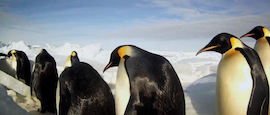2012 Press Releases
Penguin research the BEES knees on National Geographic and BBC

The National Geographic article is based on research into Emperor Penguin jumping which was recently published by a team including Professor John Davenport and senior researcher Marc Shorten of the Department of Zoology, Ecology and Plant Science, UCC, Roger Hughes of Bangor University and Poul Larsen of the Technical University of Denmark. The paper proposed a novel hypothesis, that air bubbles released as penguins ascend out of the water form a lubricating layer, which reduces friction and therefore speeds up the ascent.
The research will also feature in a BBC4 programme on bubbles to be broadcast in 2013.
This is the second occasion in recent days that BEES research has been featured by National Geographic. Research in the mid-atlantic on deep-sea vents was part of the Alien Deep episode broadcast last Sunday on the National Geographic Channel.
Read the National Geographic article here.
---
Video: Watch National Geographic photographer Paul Nicklen (whose photographs accompany this month's article) capturing emperor penguin ascents in Antartica.
